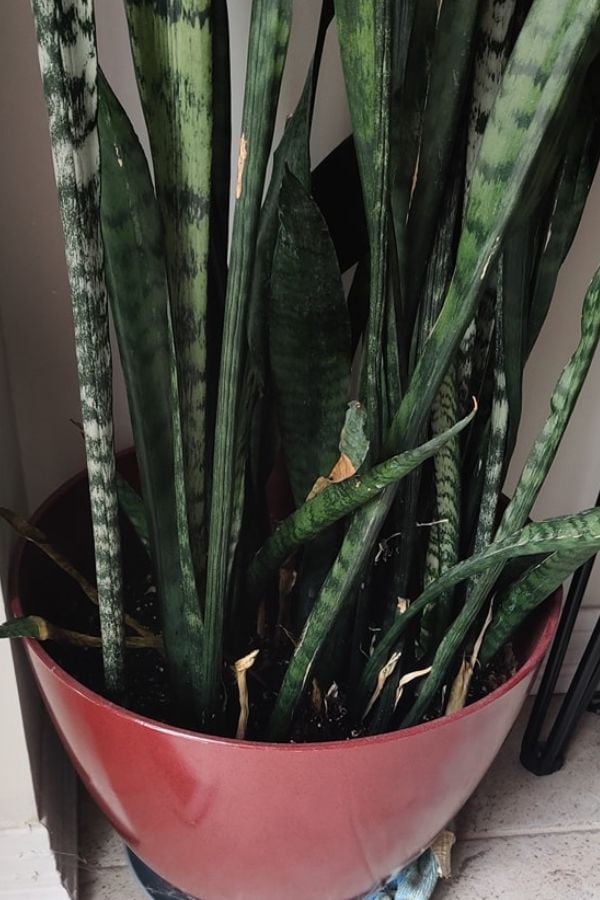The snake plant, or sansevieria, charms many of us with its thick, straight, succulent leaves. Its petite size makes it an ideal choice for homes where space is a luxury.
But, after a lengthy growth period, you might notice your once robust leaves becoming slender. Despite your dedicated care, the leaves continue to thin out, and you can’t seem to figure out why.
Here’s the deal: we’re going to unravel this mystery together. We’ll dive into why the leaves of your beloved snake plant are diminishing in thickness, and why the plant itself seems to be losing its strength.
Contents
Why Does the Snake Plant Become Skinny?
Snake plants are a popular indoor plant selection because they flourish even in dim conditions and gracefully handle partial shade. However, snake plants, also known as Sansevieria, may tend to thin out when they don’t get enough sunlight.
Contrary to common belief, these resilient plants do enjoy basking in the sun, and if kept indoors year-round, they might struggle with a lack of sunlight.
While snake plants can usually withstand periods of low sunlight, continued deprivation can cause them to weaken. Over time, insufficient sunlight may even lead their leaves to slim down.
Watch as their leaves reach skyward for sunlight, especially from spring to fall, when the plant shows the most vigor. When deprived of sunlight for extended periods, the leaves may become spindly and slender.
Roots Became Overcrowded
Imagine not repotting your snake plant for over two years. The roots may start to feel crowded and compete for space, causing the leaves to get skinnier.
When roots fight for room, their ability to absorb water and nutrients suffers. Further, with limited space in the pot, leaves may not develop properly and instead elongate to become long and thin.
Unfortunately, once the leaves have thinned, you can’t return them to their original state.
How I Made The Leaves of My Snake Plant Thicker
The photo below paints a picture of a snake plant with leaves that are shrinking due to insufficient light. It appears frail and thin. However, it wasn’t a lost cause!
The following image shows a thriving snake plant that I nurtured outdoors during the sun-soaked spring and summer months.
You can see the stark difference in the health and vitality of the same plant, demonstrating that with the right care and exposure to sunlight, we can promote thicker growth in our beloved snake plants.
The emergence of these new leaves is accompanied by an increase in their thickness.
You can see that restoring the already thin leaves to thick leaves is difficult (almost impossible), but you can cause new strong leaves to develop by moving the plant.
Place your snake plant in the sun if you want it to grow thick and strong, as long as the temperature is suitable for snake plants.
Remember that the direct summer sun can severely burn the leaves of a snake plant.
Key Points to Remember
This article focuses on factors contributing to a snake plant’s diminished thickness.
When a snake plant appears thinner, it often indicates insufficient sunlight. Even in a sunny room, the light intensity can change when filtered through a window.
A dirty, cloudy window, or one treated to block UV rays, can significantly alter the plant’s growth compared to its potential growth outside in direct sunlight.
Keep the leaves dust-free by occasionally wiping them with a damp cloth. Dust can obstruct sunlight.
Remember, “indoors” can vary significantly depending on the location. A plant near a window will have different light exposure than one near a wall. Furthermore, the window’s direction (south or north-facing) significantly affects the light’s intensity.
When relocating pots, acclimatize them gradually to sunlight. A sudden shift outdoors could scorch the plant’s leaves.
Reasons Why Snake Plants Become Skinny:
- Insufficient sunlight is primarily to blame.
- Congested roots can also lead to thinning because they inhibit smooth growth.
- Leaves located in the center of the plant tend to be thinner, as they’re often shadowed by other leaves, reducing their light exposure.








